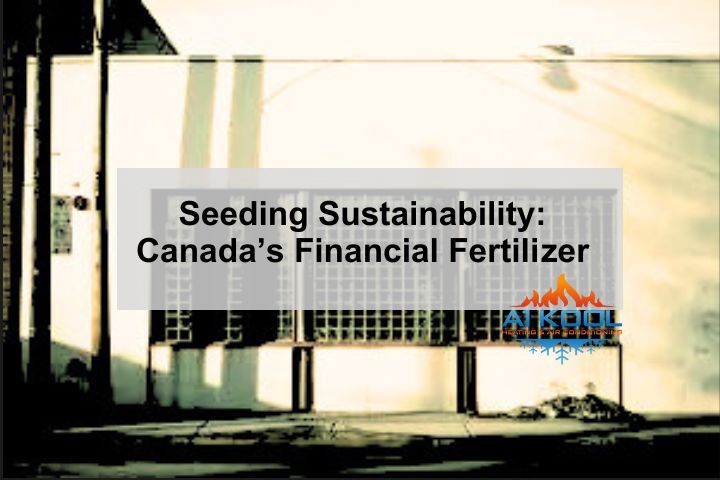In recent years, sustainability (Seeding Sustainability: Canada’s Financial Fertilizer) has grown from a trendy buzzword to a core principle guiding policy and economic initiatives globally. As climate change, environmental degradation, and resource depletion threaten the future, governments, businesses, and individuals increasingly seek innovative solutions to mitigate these challenges. In this context, Canada has emerged as a pivotal player, leveraging its vast natural resources and financial systems to seed a new era of sustainability. The country’s economic model is evolving to integrate environmental responsibility, social welfare, and economic viability—essentially becoming a financial fertilizer for sustainability. This article will explore how Canada is fostering a sustainable future through financial mechanisms, policy frameworks, and innovative green technologies.

The Intersection of Finance and Sustainability
Sustainability is no longer confined to the realms of environmental activists or scientists. Today, it’s a strategic business decision, an investor priority, and a government mandate. This is particularly true in Canada, where the financial system has become a central tool for driving sustainable initiatives. Canada is building a robust framework to tackle climate change and promote long-term prosperity by mobilizing capital towards green technologies, clean energy projects, and sustainable industries.
Sustainable Finance as a Growth Catalyst
Sustainable finance, or green finance, refers to investment and lending practices incorporating environmental, social, and governance (ESG) factors into financial decision-making. Canada has embraced this concept as a way to meet both climate goals and economic objectives. For instance, the issuance of green bonds has gained considerable traction in recent years. Green bonds are debt securities issued to finance projects with positive environmental benefits, such as renewable energy, energy efficiency, and sustainable agriculture.
In 2019, the Canadian government issued its first sovereign green bond, marking a milestone in the country’s sustainable finance journey. Provinces like Ontario and Quebec have followed suit, issuing green bonds to support environmentally friendly projects. Canadian corporations have proactively tapped into this growing market, particularly in the energy, mining, and transportation sectors.
Moreover, Canada has committed to significant investments in climate adaptation and mitigation. The federal government has launched initiatives like the Canada Infrastructure Bank (CIB), which aims to invest billions in green infrastructure, including renewable energy, public transit, and water systems. The CIB’s mandate aligns with Canada’s broader climate goals, such as achieving net-zero emissions by 2050.
The Role of ESG in Investment Strategies
Incorporating environmental, social, and governance (ESG) criteria into investment strategies has become a powerful trend in the Canadian financial landscape. ESG investing prioritizes companies with strong ethical practices, sustainable business models, and responsible governance. Canadian pension funds, such as the Canada Pension Plan Investment Board (CPPIB) and the Ontario Teachers’ Pension Plan (OTPP), have been at the forefront of integrating ESG into their portfolios.
ESG investing helps mitigate risks associated with climate change, regulatory shifts, and social inequality by emphasizing long-term value creation. In fact, Canadian institutional investors have become increasingly vocal about the need for companies to adopt sustainable practices. The CPPIB, for example, has committed to achieving net-zero emissions across its portfolio by 2050 while also investing in green energy and sustainable infrastructure projects worldwide.
This trend is not limited to institutional investors. Retail investors are also seeking out sustainable investment options, with ESG funds experiencing significant growth in Canada. According to the Responsible Investment Association (RIA), responsible investment assets in Canada surpassed $3.2 trillion in 2020, reflecting the growing appetite for investments that align with ethical and environmental values.
Policy Frameworks Supporting Sustainability
Canada’s push towards sustainability is underpinned by a comprehensive policy framework designed to create an enabling environment for green finance and sustainable development. The country has implemented key policies incentivizing sustainable business practices, regulating carbon emissions, and promoting clean energy innovation.
Carbon Pricing: A Pillar of Environmental Policy
Canada’s carbon pricing system is one of the cornerstones of its environmental policy. Introduced in 2019, the federal carbon tax applies to provinces without carbon pricing systems, ensuring that every region contributes to reducing emissions. The carbon price is set to rise steadily over time, creating a financial incentive for businesses and consumers to reduce their carbon footprint.
Revenue generated from the carbon tax is reinvested into green initiatives, including energy efficiency programs, clean technology development, and climate resilience projects. In this way, carbon pricing not only encourages emissions reduction but also provides a source of funding for sustainable projects.
Clean Energy and Innovation
Canada also invests heavily in clean energy to transition away from fossil fuels. Hydroelectric power has long been a major component of Canada’s energy mix, but the country is now ramping up efforts to expand wind, solar, and biomass energy production. The federal government’s Clean Energy Fund supports the development of renewable energy technologies, while tax incentives encourage private sector investment in green energy.
One of the most promising areas of innovation is the development of carbon capture and storage (CCS) technology, which captures CO2 emissions from industrial processes and stores them underground. Canada is home to some of the world’s largest CCS projects, including the Boundary Dam in Saskatchewan, the world’s first large-scale coal-fired power plant to use this technology. These advancements position Canada as a global leader in carbon management and emissions reduction.
Sustainable Agriculture and Natural Resource Management
Canada’s vast natural resources play a critical role in its economy, but they also present a unique set of challenges regarding sustainability. In particular, the agricultural and forestry sectors are significant contributors to greenhouse gas emissions and biodiversity loss. However, through sustainable practices and financial incentives, Canada is working to transform these industries into stewards of the environment.
The federal government’s Agricultural Clean Technology Program funds farmers and agribusinesses to adopt sustainable technologies and practices, such as precision agriculture, which reduces water and fertilizer use. Similarly, the forestry sector is exploring sustainable logging practices that promote biodiversity and forest regeneration while supporting rural communities’ economic vitality.
The Private Sector’s Role in Sustainability
The private sector is increasingly important in driving sustainability in Canada. Many Canadian companies are setting ambitious environmental goals and adopting circular economy models to reduce waste and minimize environmental impact. For example, major corporations in the energy sector, such as Suncor and Enbridge, are investing in renewable energy projects and committing to net-zero emissions by mid-century.
Technology companies also contribute to Canada’s sustainability push by developing innovative solutions to environmental challenges. Canadian tech firms are at the forefront of the global sustainability movement, from AI-powered energy efficiency systems to blockchain-enabled supply chain transparency.
Startups and entrepreneurs leverage venture capital and impact investment funds to bring green technologies to market. Canada’s growing clean-tech sector is attracting significant domestic and international investment, further reinforcing the country’s position as a hub for sustainable innovation.
Challenges and Opportunities Ahead
While Canada has made impressive strides towards sustainability, significant challenges remain. The country heavily depends on natural resource extraction, particularly oil and gas, which complicates its transition to a low-carbon economy. Balancing economic growth with environmental protection will require difficult trade-offs and sustained policy action.
However, these challenges also present opportunities. As global demand for clean energy and sustainable products increases, Canada has the potential to become a major exporter of green technologies and renewable energy. By positioning itself at the forefront of the sustainability movement, Canada can safeguard its future and contribute to global climate solutions.
Canada’s journey toward sustainability is multifaceted, involving a combination of financial innovation, policy initiatives, and technological advancements. Canada effectively seeds sustainability by leveraging its economic systems, integrating ESG factors into investment strategies, and fostering clean energy and sustainable resource management. While challenges remain, the country’s commitment to sustainability offers a promising model for the rest of the world. As Canada fertilizes its economy with green finance and innovation, it paves the way for a more resilient, prosperous, and sustainable future.
FAQs – Seeding Sustainability: Canada’s Financial Fertilizer
1. What is sustainable finance, and how is Canada using it to promote sustainability?
Sustainable finance includes investment and lending practices incorporating environmental, social, and governance (ESG) factors. Canada actively uses sustainable finance to support green technologies, renewable energy projects, and environmentally responsible industries. The country is mobilizing capital to address climate change and foster long-term economic growth through green bonds, ESG investing, and initiatives like the Canada Infrastructure Bank.
2. How does Canada’s carbon pricing system work, and how does it contribute to sustainability?
Canada’s carbon pricing system taxes carbon emissions, creating a financial incentive for businesses and consumers to reduce their carbon footprints. Provinces either implement their carbon pricing systems or fall under the federal carbon tax. Revenue from carbon pricing is reinvested into green initiatives like clean energy, energy efficiency programs, and climate resilience projects, driving emissions reductions while funding sustainability efforts.
3. What role does the private sector play in Canada’s sustainability efforts?
The private sector plays a crucial role in advancing sustainability in Canada. Corporations are setting ambitious environmental goals, investing in renewable energy, and adopting circular economy models to reduce waste. Many Canadian companies, especially in energy, technology, and agriculture, are transitioning to sustainable practices, contributing to the national effort to reduce carbon emissions and promote environmental responsibility.
4. How is Canada’s financial system supporting clean energy and innovation?
Canada’s financial system is fueling the clean energy sector through investments and funding mechanisms such as green bonds and government-backed initiatives like the Clean Energy Fund. Venture capital and impact investment funds are also helping to scale innovative green technologies, including carbon capture and storage (CCS), renewable energy projects, and AI-driven energy efficiency systems, positioning Canada as a global leader in sustainability innovation.
5. What challenges does Canada face in achieving its sustainability goals?
One of Canada’s primary challenges is its reliance on natural resource extraction, particularly oil and gas, which complicates its transition to a low-carbon economy. Balancing economic growth with environmental sustainability requires careful policymaking and difficult trade-offs. However, Canada’s focus on green finance, clean technology, and sustainable resource management offers significant opportunities for overcoming these challenges and contributing to global climate solutions.



